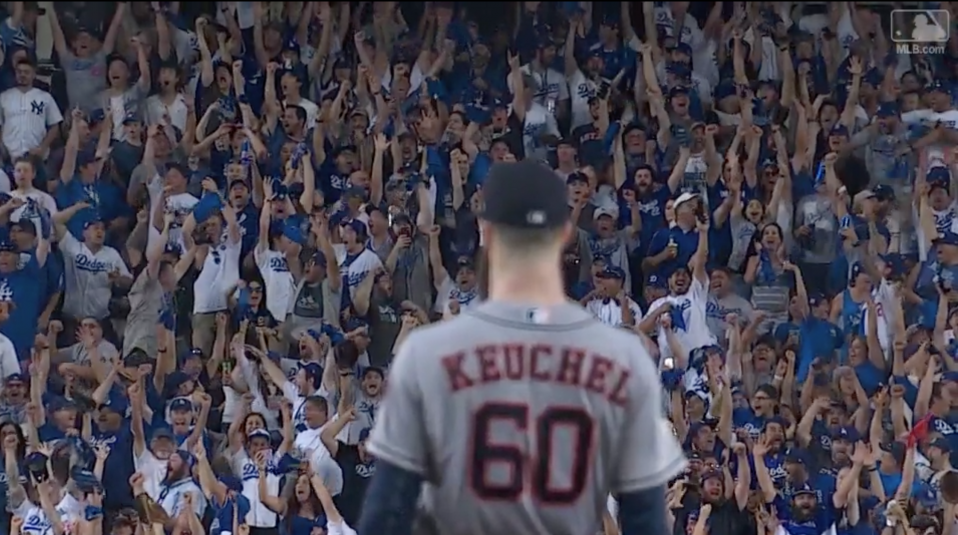SVG Sit Down: Fox Sports World Series Director Matt Gangl on Tech, Storytelling, and Following in the Footsteps of a Legend
Directing his first World Series, the vet of the front bench chats about his ‘humbling’ experience
Story Highlights
This year’s World Series is already shaping up to be a doozy, with spectacular pitching performances, the mainstream emergence of stars like Justin Turner and Jose Altuve, and a wild finish to Game 2 that has the Fall Classic knotted at one game apiece heading to Houston this weekend. One of the more intriguing storylines of this World Series, though, can be found behind the scenes, where there has been a changing of the guard in the director’s chair.
Matt Gangl, a Fox Sports veteran of who regularly directs Minnesota Twins games for Fox Sports North and has directed American League and National League Division Series over the past four years, is calling the shots on his first World Series.

Matt Gangl regularly directs Minnesota Twins games and more at the regional sports network Fox Sports North.
It’s a highly coveted position, one that, for many years, was occupied by beloved industry icon and Class of 2016 Sports Broadcasting Hall of Famer Bill Webb, who died in March following a fight with cancer.
Gangl took a few minutes with SVG in Houston prior to Game 3 to discuss the emotions of directing his first Fall Classic, what technology he sees as the most effective storytelling tools, what makes his directing style unique, and what it’s like to follow in the footsteps of a legend.
You’ve been directing baseball games for a long time. You’ve even worked on the big stage with Fox Sports at events like the MLB All-Star Game. But has anything about working the MLB Postseason surprised you?
This is one of the best times of the year to cover any sport. Every pitch matters. Every call. Every play. Every decision the manager makes. There’s such a high level of emotion about it. It’s just an enjoyable experience from my standpoint. I can try to paint a picture and tell all of those stories with all of the shots that we bring in. I want to bring people who are watching at home a little bit closer to that emotion.
Bill Webb played a major role in crafting the Fox Sports on-air look from the early days of baseball on the network. Over the years, what did you learn from him that has influenced the type of Fox Sports baseball director that you have grown into?
Bill changed the game. He changed how baseball was presented on television by adding more cuts, more tight shots. He created pace in a game that can lack pace. When I think of Bill, It influences me in the moments that I’m looking for. I’m trying to make sure that we’re showing every situation and setting it up for the viewer. Are there runners on base? Who’s on deck? Is there someone in the bullpen? Is there a pinch hitter getting ready? Those are all of the little things that you can do as a director that can present the game in its fullest to the viewer at home.
For me, it’s really humbling to be in this position following Bill. He was a great man, and, to me, he’s the best that’s ever done what I do for a living. I don’t think there’s any argument there. Ten years, 15 years ago, this time of the year I loved watching the Postseason to watch what he would do, to live it through his eyes. So to be in this spot now? I feel like I’ve got to pinch myself.
In what ways are you different? Obviously, what the World Series looks like on Fox is the result of the work of many, many people. But what do you bring to the table that you feel is unique?
I’m very big into getting new technologies that we can get into [the broadcast]. I want more access for our cameras on the field, bringing the fans closer to the action by bringing them onto the field during key moments when Major League Baseball allows us. I’m always trying to tell as much as I can of both sides of the story. When there’s a two-run home run that was hit, I want to be sure to go back to the error that let the first guy get on base. When a big home run is hit, there’s elation on one side, but, on the other side, there is dejection.
High-speed cameras have been deployed by Fox Sports for years now, and, even at the RSN level, there’s been a push to the high-speed, specialty cameras. Have you ever had this many options at your disposal?
[Laughs] No. No. It’s tremendous because you can have all of the bases covered and still take some chances with the other ones. You can look for unique reactionary moments on the field or in the dugout. There are just certain players like Yasiel Puig and Jose Altuve where you’re going to have that opportunity, and having so many more resources at your fingertips makes it fun to not only capture what happened but see it all pay off with three or four other shots to convey the emotion of that moment from a player — or even a fan in the stand. Fans are living and dying on every pitch, and we’re getting some great replays of their reactions. I think it adds such a different element. Our Phantom cameras are operating at over 2,000 frames per second, so we’re talking about capturing moments that people have never seen before. It’s something that you definitely can’t see with your naked eye. It not only gives our viewers a crisp, clean picture but shows just how much of the game comes down to fractions of inches.
Statcast has become more integrated in MLB broadcasts across the board, and it tends to get a mainstream spike in interest during the Postseason. What’s your opinion on how that has grown as a storytelling tool, and in what ways do you like to deploy it?
I think it definitely has its moments where it can tell a good story. For me, some of those moments are more on the defensive side with route efficiency and top speed. The exit velocity is nice, but the ball was hit hard. That ball could be a line drive to the shortstop, or it could be a home run.
There’s also been a lot of talk about launch angle with players like Daniel Murphy who are trying to get more of an upper cut and swing for more home runs. Those don’t do as much for me personally. We need to be able to quantitatively provide data that can give people at home an idea of why this was an exceptional play.
I think, as we move forward, we need to do a better job of giving what the averages are on some of this data. If a runner goes from first to third and his top speed was something and he did it in whatever time, well, what’s the average runner? [That’s] critical to understand how good this play is or if it was just normal.
What other technology available to you and your colleagues in the compound has you excited? What technology do you expect to alter live sports storytelling?
There’s a lot of different things out there, and we used one in L.A. [during Games 1 and 2], where we had two robotic cameras at low home with high-end lenses on them. They allow us to shoot past leftie to righty batters. Both are operated by one operator not sitting in the stands but remotely. That is exciting to me because we can put a camera at a low-home position and get that tight emotional shot of the pitcher without having to do a bunch of seat kills and move a bunch of fans. The operator we have on it has been really good.

An “outstanding shot” in Game 1 told the story of different emotions in a Dodgers home run off Astros pitcher Dallas Keuchel.
We’ve gotten some great slo-mo replays from those, too. We got an outstanding shot in Game 1: the Dodgers hit a home run, and [Astros pitcher Dallas] Keuchel is in the foreground out of focus; the fans where the ball is landing are in focus, and, as they rise up and cheer it, [the shot] rack-focuses onto Keuchel. It was unbelievable. It’s just a [camera position] that’s gone away in baseball because those areas are so valuable to the teams for selling tickets, and I get that. It harks back to Andy Pettitte and the types of shots we got of him peering over his glove. You got the intensity of the pitcher.
What’s your advice for young directors who may be working on live productions at a college or in the minors. In today’s rapidly changing media environment, how can they plot a road to succeed in this field calling things from the front bench?
Know as much about all aspects of the production as you possibly can. Anybody in the producer’s or director’s seat needs to understand how the whole process comes together. If I can have knowledge of audio, running a camera, technical directing, running graphics, all of those little things; if I know more about how those people do their jobs, personally, as a director, I can communicate what I’m looking for in ways that are easy to understand and can get everyone going to the right place. I also understand that, if there’s something going on or we’re having difficulty in a certain area, I can formulate a Plan B. The more that you understand the process, I think you can better lead the process.
On top of that is knowledge of the game, knowledge of the teams you are covering, listening to your announcers, telling good stories, and taking chances. Take risks: sometimes they’re not going to pay off, but, when they do, you can capture some exceptional moments. Don’t be afraid of that.
Fox Sports’ coverage of the World Series resumes Friday night (8 p.m. ET) in Houston when the Astros and Dodgers meet in Game 3.
